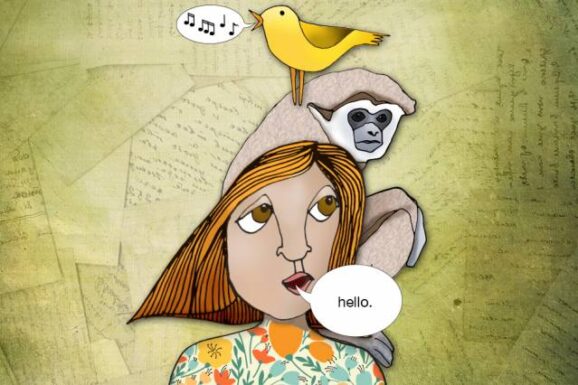Human Speech Integrates Animal Sounds
This article is more than 2 years old
 I talk to my cat all the time, and much of the time she “talks” back. I’ve learned to identify her various meows — they sound different depending on whether she’s hungry, lonely, bored, irritated, frightened, etc. It always amazes me that a domestic creature can make all of those different, emotive sounds. Then there are dolphins and monkeys, who have languages that have evolved to express the range of more complex wants and needs they have. It makes sense, then, that humans may have learned some of their speech habits from animals, however unconsciously. Two MIT professors just published a paper in Frontiers in Psychology outlining something they call the “integration hypothesis,” which posits that human language systems have natural antecedents.
I talk to my cat all the time, and much of the time she “talks” back. I’ve learned to identify her various meows — they sound different depending on whether she’s hungry, lonely, bored, irritated, frightened, etc. It always amazes me that a domestic creature can make all of those different, emotive sounds. Then there are dolphins and monkeys, who have languages that have evolved to express the range of more complex wants and needs they have. It makes sense, then, that humans may have learned some of their speech habits from animals, however unconsciously. Two MIT professors just published a paper in Frontiers in Psychology outlining something they call the “integration hypothesis,” which posits that human language systems have natural antecedents.
Linguist and Japanese Language and Culture professor at MIT, Shigeru Miyagawa and his colleagues explain that human language basically has two components: expressive (E) and lexical (L). Each of those components are found in the wild — for example, E is demonstrated in the songs of birds in the melodies and sounds, and L can be observed in the warning cries of primates, because those sounds carry actual content and meaning. But E and L are both finite — there are limits to what they can express. What’s amazing about the human language is that it’s infinite.
Miyagawa and his team believe that while human language can express infinite meanings, when analyzed closely it still retains the mark of the finite expressions used by animals. Linguists have generally held that something called “discontiguous word formation” accounts for the infinite qualities of human language — that’s when we add prefixes, suffixes, and other words into sequences to change their meaning (in the paper, they use the example of the prefix “anti” and the noun “missile,” as it can be extended into “antimissile missile” or “anti-antimissile missile missile.” But Miyagawa argues that discontiguous word formation isn’t what accounts for the infinite nature of human language because “each successive expansion forms via strict adjacency” — essentially, that humans put together finite or discrete pieces of language. Animals don’t join finite and infinite linguistic states — that’s a uniquely human innovation, as is the grammar that bridges the two.
Primates introduced the lexical component to language, and the team is currently studying how that kind of language merged with birdsong. The key may reside with the silvery gibbon, which lives in Indonesia and sings complicated, meaning-laden songs that use over a dozen different types of notes. While the synthesis of these linguistic components may be unique to humans, the building blocks seem to have been present in nature long before we got here. I wonder if the learning curve goes the other way — I’ve obviously taught my cat how to achieve specific results with her various meows. And I’m pretty sure she talks about me behind my back when she’s Skyping with other cats.












